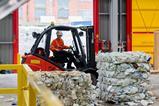A new computer program compiles library of untapped aromatic heterocycles
UK scientists have created a computer program to work out all the aromatic heterocycles that could be synthesised, hoping to expand the range of molecules used in the pharmaceutical and other industries.
William Pitt and colleagues from UCB Celltech in Cambridge and Slough have created the virtual exploratory heterocyclic library, dubbed VEHICLe, which contains over 3,000 heterocycles considered ‘synthetically viable’.
Heteroaromatic ring systems are often used as the core of drugs or agrochemicals, but a survey of the literature showed that only 1,701 different cycles had ever been synthesised. Less than 10 novel small heteroaromatic ring systems are published each year, the researchers estimate, and the number is falling.
Pitt explains that VEHICLe could be a powerful tool in drug discovery: ‘If you have a natural product or a competitor’s drug molecule, but you want to replace the ring system - either because the original has problems or the patents are owned by someone else - then you could replace the core with a new ring system that overcomes those problems and is in a clear patent space.’
The VEHICLe database was generated using a learning computer program, which first identified all possible five- and six-membered heterocycles and bicycles containing nitrogen, oxygen and sulfur heteroatoms. ‘A lot of these ring systems obviously didn’t make chemical sense,’ explains Pitt, ‘so we came up with a machine-learning method to filter out ones which weren’t of any interest.’ The program was then taught to be able to give an indication of which ring systems would be synthetically accessible.
‘I was surprised by how well it works,’ Pitt adds, ‘we’ve already applied VEHICLe to several projects within UCB where we needed to substitute heterocyclic systems that we were unhappy with.’
‘We’d love people to try and make some of these molecules,’ says Colin Groom from the Cambridge Crystallographic Data Centre, who collaborated on the work, ‘because that will show whether or not our predictions are right about which ones can and can’t be made’.
References
W Pitt et al.J. Med. Chem., 2009. DOI: 10.1021/jm801513z

















1 Reader's comment